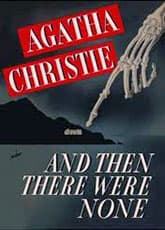And Then There Were None
Critique • Quotes • At the movies
 First US edition, 1940
First US edition, 1940Also known as
Ten Little Indians
First publication
1939
Literature form
Novel
Genres
Crime, mystery, thriller
Writing language
English
Author's country
England
Length
Approx. 53,500 words
Ten little problems with the world's most popular mystery
Despite issues with objectionable titling over the years, And Then There were None has been not only the most popular novel by Agatha Christie during her long, prolific career, but one of the best-selling books of all time—ranked only a few spots behind the Bible.
It's also one of the Christie books that you have to read quickly, to keep from overthinking the unbelievable characters and situations. Fortunately, she's got the knack of writing to speed you obliviously past such issues.
A large part of the appeal has got to be the plot, which was startlingly novel at the time. It's still effective today after we've had generations of thrillers and slashers in which all the characters are knocked off one at a time.
But this is not to denigrate the appeal also of the writer's ability to squeeze the most suspense possible out of the plot. It's relentless. Starting with the quick profiles of the actors in this drama as they each ponder their mysterious invitation to the house on an island, everyone obviously hiding a great secret in their pasts... the mystery ratcheting up as they realize they are stranded... at the mercy of an unknown killer avenging their sins... suspecting and turning on each other as their numbers drop off... one by one... until....
And that's one of Christie's favourite and most annoying writing tricks: the use of ellipses (...) to build anticipation and suggest inexpressible terrors to come. More of a writing tic really, as she overuses those dot-dot-dots. One can almost hear the horror movie crescendos.
But why not? It helps keep the word count down to nearly novella lengths. This is a surprisingly compact piece of writing to contain so many murders and plot twists. Nothing fancy. Characters more like caricatures, revealed in brief internal monologues. Pointed dialogue that all sounds the same regardless of who's speaking.
Not much description, given the strange locale. The foreboding atmosphere is nearly all due to the dire situation the characters find themselves in and to their dark thoughts. An odd fact is that the house is paradoxically supposed to be relatively modern with bright, clean lines, without dark nooks or hidden passages—and yet every book cover and most film adaptations feature the Gothic-style mansions of horror story fame.
Also unusual is that this mystery has no mystery-solver—that is, no detective. Unless you consider everyone on the island is both suspect and detective.
Stream of unconsciousness
About those internal monologues though. How is it we drop in on the thoughts of all the players in this drama and never when they happen to be thinking about anything that would give away whether they are the obsessive killer?
This is a stunt Christie—and many another writer, to be fair—has pulled in other novels, but never to this extent. It's one of those many things in And Then There were None that don't make sense but probably don't bother many readers even if they notice it. Just part of the mystery game.
You might expect the stage adaptation that Christie created four years after the novel came out would alleviate this issue because a play has to rely on characters' behaviour, not their thoughts. But the play, in which the bleak ending is also changed to a happier one, opens up several other plot holes. The time between killings, for example, is reduced for theatrical presentation, not allowing the characters to react realistically.
In any case, Agatha Christie commonly skips over any normal human reactions to tragedy to get to the mystery-solving. But in this novel the people are particularly heartless. Even the butler whose wife is one of the first victims recovers in time to serve dinner to the rest.
But what may disturb readers most today is a certain racist term used at least twice in the novel as it now stands, I believe. The use of the word here cannot be defended on the same grounds as it can in Mark Twain's Huckleberry Finn, which puts it in characters' mouths in an earlier century.
The expression is a holdover from the first British publication of Christie's novel under the title Ten Little N———s, referring to a children's rhyme recited in the story and reflected in the name of the island. Even at the time it was thought this was objectionable enough that in the first American edition the title was changed to the last line of the rhyme, "And then there were none." In Britain, the N-words in the title, in the rhyme and in the island's name were replaced by reference to Indians. This too, of course, could hardly stand and in some editions the "Indians" in the text were changed to "Soldiers," while in others "Indians" is kept in the text but the title changed to the American version. However, even in these later editions, some casual uses of the original hideous N-word have survived.
Apart from all these problems, the novel stands out as one of those Christie novels with a game-changing resolution. The Murder of Roger Ackroyd and Murder on the Orient Express had earlier both roused indignation that Christie wasn't playing by the rules but won her greater fame. Her fervent fans were waiting for another thinking-outside-the-box mystery.
They got it, and then some, with her 1939 mystery on an island. Whatever it was called.
— Eric
Critique • Quotes • At the movies

